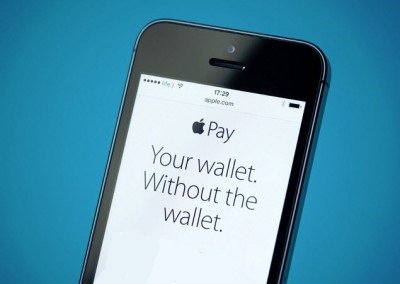Study shows that Apple Pay continues to struggle to find a foothold with consumers
Relatively few people are using Apple’s new mobile payments service, called Apple Pay, according to a new study from Trustev. Apple released its mobile payments service earlier this year, with the backing of several large retailers and banks. In the United States, the service has struggled to find a foothold among consumers, as they appear to favor other payment services that were also recently released in the country. As a market, mobile payments continues to grow in the U.S., with more consumers favoring paying for products with their smartphones and tablets.
Digital wallets are gaining popularity among consumers
Many mobile payment services operate in the same manner, serving as a form of digital wallet that can store information from consumers and retailers. Digital wallets have become very attractive to consumers because they provide a convenient way to purchase products. A growing number of retailers are beginning to support mobile payments in their physical stores and these digital wallets are becoming quite important to consumers.
20% of iOS users are making use of Apple Pay
 According to the study from Trustev, only 20% of people participating in mobile payments in the United States are using Apple Pay. Of those using Apple Pay, 56% have reported that they have used the service once during a typical week. Another 15.3% say they have never used it during their week. While few people may be using Apple Pay, fewer are using other services provided by Google and Samsung. All of these services have been competing for the attention of consumers, but they have struggled to find a foothold with mobile shoppers.
According to the study from Trustev, only 20% of people participating in mobile payments in the United States are using Apple Pay. Of those using Apple Pay, 56% have reported that they have used the service once during a typical week. Another 15.3% say they have never used it during their week. While few people may be using Apple Pay, fewer are using other services provided by Google and Samsung. All of these services have been competing for the attention of consumers, but they have struggled to find a foothold with mobile shoppers.
Apple Pay may continue to struggle to find support among consumers
One of the challenges that Apple Pay faces is that it is only available to a very small portion of society. The service can only be used by those with the latest iPhones. While the device has proven to be quite popular among Apple fans, relatively few people have the latest edition of the company’s flagship smartphone.
Consumers in the United Kingdom will spend an estimated £2.3 billion making purchases on smartphones and tablets.
Recent statistics released by a forecast from Adobe have shown that shoppers in the United Kingdom will be using mobile commerce this year more than ever before when it comes to buying everything they need for their Christmas celebrations.
The prediction from the forecast is that m-commerce will comprise 23 percent of all online holiday shopping.
That percentage will mean that about £2.3 billion of holiday purchases in the United Kingdom will have been made over mobile commerce, this year. The Adobe study predicts that sales overall will also increase by 7 percent when compared to last year, bringing the total to a hefty £17.7 billion. Online shopping will make up about 57 percent of that total figure. The U.K. will also experience the largest one-day shopping peak online when compared to all European countries. The prediction is that “Black Friday” on November 27 will generate £474 in online sales. The average spending across the country will be £8.06 per person on that one day.
The portion of the spending that will occur over mobile commerce has never been higher in the U.K.
 Mark Zablan, the president of Adobe EMEA, said that “This year’s report once again underscores the importance of the Christmas shopping season as a driver for eCommerce across Europe, giving consumers the ability to take advantage of low prices, retailer offers and product variety without battling crowds on the High Street.”
Mark Zablan, the president of Adobe EMEA, said that “This year’s report once again underscores the importance of the Christmas shopping season as a driver for eCommerce across Europe, giving consumers the ability to take advantage of low prices, retailer offers and product variety without battling crowds on the High Street.”
That said, Zablan also pointed out that consumers are looking for more than a great deal. The Adobe report underscored the importance of being able to obtain access to product reviews in order to make their buying choices. Social media is also expected to continue to play a vital role in the decision making process for Christmas present shopping.
He indicated that European retailers will want to pay close attention to those insights, as it means that they will need to go beyond simply advertising that they have the best deals. They will be required to “create meaningful opportunities to engage with consumers throughout the customer journey that will drive them to the point of purchase.” In that effort, Zablan said that social media will be a central mobile commerce player.
 According to the study from Trustev, only 20% of people participating in mobile payments in the United States are using Apple Pay. Of those using Apple Pay, 56% have reported that they have used the service once during a typical week. Another 15.3% say they have never used it during their week. While few people may be using Apple Pay, fewer are using other services provided by Google and Samsung. All of these services have been competing for the attention of consumers, but they have struggled to find a foothold with mobile shoppers.
According to the study from Trustev, only 20% of people participating in mobile payments in the United States are using Apple Pay. Of those using Apple Pay, 56% have reported that they have used the service once during a typical week. Another 15.3% say they have never used it during their week. While few people may be using Apple Pay, fewer are using other services provided by Google and Samsung. All of these services have been competing for the attention of consumers, but they have struggled to find a foothold with mobile shoppers.
 Mark Zablan, the president of Adobe EMEA, said that “This year’s report once again underscores the importance of the Christmas shopping season as a driver for eCommerce across Europe, giving consumers the ability to take advantage of low prices, retailer offers and product variety without battling crowds on the High Street.”
Mark Zablan, the president of Adobe EMEA, said that “This year’s report once again underscores the importance of the Christmas shopping season as a driver for eCommerce across Europe, giving consumers the ability to take advantage of low prices, retailer offers and product variety without battling crowds on the High Street.”